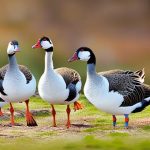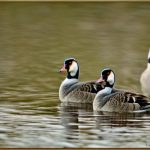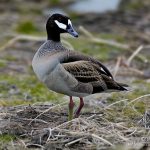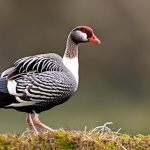Canadian Geese, also known as Canada Geese, are a familiar sight in North America, known for their distinctive black heads and necks, white patches on their faces, and brown bodies. These large waterfowl are a common sight in parks, golf courses, and other open spaces, where they can often be seen grazing on grass or swimming in ponds and lakes. Canadian Geese are known for their distinctive honking calls, which can be heard as they fly in V-shaped formations during their annual migrations. These geese are highly adaptable and can be found in a wide range of habitats, from urban areas to remote wilderness.
Nesting and Breeding Sites
Canadian Geese are monogamous birds, forming strong pair bonds that can last for many years. They typically begin nesting in early spring, with the female selecting a suitable site for the nest. Nesting sites are often located near water, such as on islands in lakes or along the shores of rivers and ponds. The female constructs the nest from grasses, reeds, and other plant materials, creating a shallow depression lined with down feathers. The male stands guard nearby, keeping watch for potential threats while the female lays her eggs. Canadian Geese are known for their strong nest site fidelity, often returning to the same nesting site year after year.
Mating Rituals and Courtship
The mating rituals of Canadian Geese are a sight to behold, as pairs engage in elaborate displays of courtship. During the breeding season, males and females engage in a variety of behaviors to attract a mate and reinforce their pair bond. This can include elaborate displays of head bobbing, honking, and wing flapping, as well as mutual preening and feeding. These displays serve to strengthen the bond between mates and establish their commitment to each other. Once a pair bond has been established, the male and female will begin the process of selecting a nesting site and preparing for the arrival of their offspring.
Incubation and Nesting Behavior
After the female has laid her eggs, she will begin the process of incubating them, sitting on the nest to keep the eggs warm and protected. The male will stand guard nearby, keeping watch for potential threats and predators. Canadian Geese typically lay a clutch of 4-7 eggs, which will hatch after an incubation period of around 25-28 days. During this time, the female will rarely leave the nest, relying on the male to bring her food and water. Once the eggs hatch, the parents will continue to care for their young, teaching them to forage for food and protecting them from potential threats.
Parental Care and Responsibilities
Once the goslings have hatched, the parents take on the responsibility of caring for and protecting their young. Canadian Geese are highly attentive parents, keeping a close watch over their goslings and teaching them essential survival skills. The parents will lead their young to feeding areas, where they can learn to forage for grasses and other plant materials. They will also protect their young from potential threats, such as predators and other geese. As the goslings grow, the parents will continue to provide guidance and protection, ensuring that their offspring have the best chance of survival.
Challenges and Threats to Breeding
Despite their adaptability, Canadian Geese face a number of challenges and threats to their breeding success. One of the biggest threats comes from habitat loss and degradation, as wetlands and other natural areas are converted for agriculture, urban development, and other human activities. This can reduce the availability of suitable nesting sites and food sources for the geese, making it more difficult for them to successfully raise their young. In addition, Canadian Geese are also vulnerable to predation from animals such as foxes, raccoons, and coyotes, which can prey on their eggs and young. Climate change is also a growing concern, as rising temperatures and changing weather patterns can impact the availability of food and water for the geese.
Migration Patterns and Breeding Grounds
Canadian Geese are known for their impressive migrations, which can cover thousands of miles as they travel between their breeding and wintering grounds. In the spring, geese will begin their northward migration, returning to their breeding grounds in Canada and the northern United States. Here, they will establish nesting sites and raise their young before beginning their southward migration in the fall. During their migrations, Canadian Geese will often stop at staging areas to rest and refuel, taking advantage of abundant food sources to build up their energy reserves for the next leg of their journey. These migrations are a remarkable feat of endurance and navigation, as the geese rely on instinct and environmental cues to guide them on their journey.
Impact of Climate Change on Breeding Habits
Climate change is having a significant impact on the breeding habits of Canadian Geese, as rising temperatures and changing weather patterns can disrupt their traditional nesting and migration patterns. Warmer temperatures can cause the early onset of spring, leading to mismatches between the timing of nesting and the availability of food sources. This can impact the survival of goslings, as they may hatch before the peak of food availability, making it more difficult for them to find sufficient food. In addition, changing weather patterns can also lead to more frequent and severe storms, which can damage nests and threaten the survival of eggs and young. These impacts of climate change are a growing concern for the long-term survival of Canadian Geese and other migratory birds.
Conservation Efforts and Protection of Breeding Sites
In response to the challenges facing Canadian Geese, a number of conservation efforts have been implemented to protect their breeding sites and support their populations. This includes the preservation and restoration of wetlands and other natural habitats, which are essential for providing nesting sites and food sources for the geese. Efforts have also been made to reduce human disturbance at nesting sites, such as through the establishment of protected areas and the enforcement of regulations to limit human activities near breeding grounds. In addition, conservation organizations and government agencies have worked to raise awareness about the importance of protecting Canadian Geese and their habitats, engaging the public in efforts to support their conservation.
Future Research and Understanding of Canadian Geese Breeding Habits
As our understanding of Canadian Geese breeding habits continues to evolve, there is a need for ongoing research to support their conservation and management. This includes studies to better understand the impacts of climate change on their breeding habits, as well as efforts to monitor their populations and track their movements during migration. Research is also needed to identify and address the specific threats facing Canadian Geese, such as predation and habitat loss, and to develop effective strategies for their conservation. By continuing to study and learn about the breeding habits of Canadian Geese, we can work to ensure the long-term survival of these iconic birds and the habitats they depend on.
Meet Walter, the feathered-friend fanatic of Florida! Nestled in the sunshine state, Walter struts through life with his feathered companions, clucking his way to happiness. With a coop that’s fancier than a five-star hotel, he’s the Don Juan of the chicken world. When he’s not teaching his hens to do the cha-cha, you’ll find him in a heated debate with his prized rooster, Sir Clucks-a-Lot. Walter’s poultry passion is no yolk; he’s the sunny-side-up guy you never knew you needed in your flock of friends!







